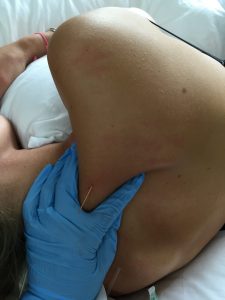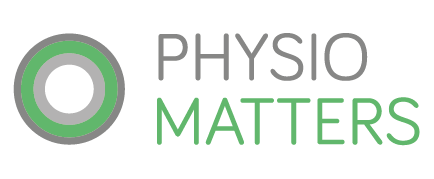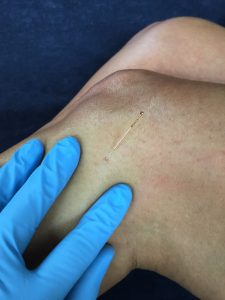 Whenever I mention that I do superficial and deep tissue dry needling as a treatment technique, the very first thing people ask me is “Is that acupuncture?” The simple answer is “No it is not”. Acupuncture uses a different mind-set and a different language. I am not an expert on acupuncture and do not want to do the individuals who practice acupuncture the disrespect of even attempting to explain its concepts and complexities. However I will discuss it in reference to comparing it with the dry needling techniques I use.
Whenever I mention that I do superficial and deep tissue dry needling as a treatment technique, the very first thing people ask me is “Is that acupuncture?” The simple answer is “No it is not”. Acupuncture uses a different mind-set and a different language. I am not an expert on acupuncture and do not want to do the individuals who practice acupuncture the disrespect of even attempting to explain its concepts and complexities. However I will discuss it in reference to comparing it with the dry needling techniques I use.
Acupuncture is based on the Traditional Chinese Medicine concept of the meridian system, a belief in a path through which the life-energy known as Qi flows. Acupuncture involves inserting very fine needles into specific points of the body to help stimulate movement of energy within the body. The goal is to restore the proper flow of Qi.
Both superficial and deep tissue dry needling techniques also use the insertion of fine acupuncture needles into different parts of the body but they are based on a western medicine concept. The decision on the site and the depth of the insertion of the needle is established through the description of the pattern of pain and symptoms which the patient experiences and the discovery of myofascial trigger points through palpation.
A myofascial trigger point is an exquisite spot of tenderness in a nodule of muscle. When pressure is applied to the tender nodule it reproduces the pain that the patient has been describing. The science behind the development of thenodule within the muscle is complex and a little hard to explain but ultimately it occurs due to over use, over loading, over stretching and over working the muscle which causes an energy crisis in the muscle, resulting in the painful nodule and referred pain pattern. The insertion of the needle (particularly with deeper muscles) helps increase blood flow to the area in a way that simple palpation cannot. This counteracts the local energy crisis and so help reduce/remove the tender nodule that is causing the pain.
Superficial dry needling technique is also used. The needle is inserted more superficially over a specific are, rather than deep into the muscle. This technique is often used for pain relief over a specific area. For example if you have sprained your ankle, superficial dry needling can be used above the injury to help relieve the pain caused by the injury. This occurs due to the stimulation of certain pain fibres that result in a natural opioid release– which is your own body’s natural pain relief. As a result of controlling the pain further therapy can commence and it reduces the risk of secondary problems associated with pain.
It is important to understand that dry needling techniques are not a quick fix. They may well help reduce/resolve some symptoms. However the reasoning behind the trigger points forming in the first place need to be established. If they are not addressed then there is a strong likelihood that the trigger points and the symptoms will return in the future. Dry needling is an excellent treatment technique to use alongside other physiotherapy treatments for example education/advice, stretches and exercises.

